Abstract
The notion of genus for finitely generated nilpotent groups was introduced by Mislin. Two finitely generated nilpotent groups Q and R belong to the same genus set if and only if the two groups are nonisomorphic, but for each prime p, their p-localizations and are isomorphic. Mislin and Hilton introduced the structure of a finite abelian group on the genus if the group Q has a finite commutator subgroup. In this study, we consider the class of finitely generated infinite nilpotent groups with a finite commutator subgroup. We construct a pullback from the l-equivalences and , , where , and compare its genus to that of H. Furthermore, we consider a pullback L of a direct product of groups in this class. Here, we prove results on the group L and prove that its genus is nontrivial.
MSC:
20B07; 20J99; 20D15; 20E9
1. Introduction
Let Q be a finitely generated nilpotent group. The Mislin genus, , is defined to be the set of isomorphism classes of finitely generated nilpotent groups R such that for every prime p, the p-localizations and are isomorphic. Mislin, in [1], gave a description of the genus set if Q is finitely generated with a finite commutator subgroup. In particular, he showed how to compute the order of the genus set . Furthermore, the authors in [2] showed that the genus set , which is finite, admits an abelian group structure with Q as its identity element.
Let G be any group. We define the noncancellation set, denoted by , to be the set of all isomorphism classes of groups K such that . Suppose that G is a finitely generated infinite nilpotent group with a finite commutator subgroup. Warfield’s result [3], asserts that .
In this study, all groups considered are supposed to be nilpotent. We therefore study the class of all finitely generated infinite nilpotent groups with finite commutator subgroups. In particular, we are interested in the class of semidirect products of the form , where T is a finite abelian group and . Many computations of the genus of nilpotent groups which belong to the class can be found in the literature [2] and [4]. We note that there is no general method for the computation of when . Hence, we describe the following subclass of .
Let Q be a nilpotent group. Consider the short exact sequence
where is the torsion subgroup of Q and is the torsion-free quotient. We have that if and only if is finite and is free abelian of finite rank. The authors in [5] defined a subclass if the following additional conditions hold.
- 1.
- and are commutative;
- 2.
- The sequence splits for the action ;
- 3.
- , where is the center of .
In the presence of (1), condition (2) is equivalent to requiring that for each there exists such that for all , as observed in [5].
For a group , the authors in [5] gave a general method for the calculation of the genus set . Let d be the height of in ; that is, , and let be the multiplicative group of units of . The authors showed that
In the case where or 2, the genus of the group Q is trivial. If has a nontrivial genus, then is cyclic. The only calculations of the genus of a group in are those groups in the class or the direct products of groups in [2,4,6,7,8].
For any m prime to d, there is a group in the genus of Q. The groups are all supposed to be finitely generated infinite nilpotent. The authors in [5] proved that , and that consists of isomorphism classes of groups . That is, there is a correspondence to , and this correspondence provides an isomorphism by (1). The groups have the same properties as those of Q.
The calculation of the Mislin genus was extended from the class to a subclass in of direct products of k copies of Q, where . If the direct product of groups , where involves a group with a noncyclic torsion-free quotient , then the genus, is trivial. The direct product of groups , each with a cyclic torsion-free quotient , is a group with a noncyclic torsion-free quotient . The authors in [4] proved that need not be trivial. Let , and be the direct power of Q, where . The authors in [5] proved that there is a surjective homomorphism
given by , where . Suppose that p is a prime. Let the torsion subgroup be a p-group, and be cyclic. The authors further showed that is an isomorphism.
If , then for we have that if and only if Q is itself commutative since, in general, does not inherit condition (3) from Q.
Mislin, in [1], defined the genus set for groups in the class , of all finitely generated infinite nilpotent groups with finite commutator subgroups. This paper is a further contribution to the notion of the Mislin genus of groups in the class . For further studies regarding the genus set of a group not in the class , see [9]. In Section 2, we discuss the group structure of the genus of a group computed by the author in [10]. We construct a pullback of l-equivalences and , , where for a prime p and , we have . We compute the group structure of the genus of the group by studying the relationship between and .
Let be a relatively prime pair of integers. Let and be -groups in . In Section 3, we prove that the group of the form is a subgroup of the direct product . In this case, the group L is a pullback. Moreover, we compute the structure of the genus set by a slight generalization of the results from [10]. Further, we describe the group such that but ; and show that consists of groups . Section 4 then closes with exact calculations for our general construction of from Section 3. We show that and that is a surjective group homomorphism, which then allows us to determine the exact structure and order of the genus group of L since we can calculate .
2. Relations between Genus Groups
We discuss the genus set for H, a finitely generated infinite nilpotent group with finite commutator subgroup. Let us first recall some notation from [2] and [1]. Denote by the center of H and by the torsion subgroup of . The group is the free center of H. In particular, the quotient H/FZH denotes the group QH. Then QHab is the abelianization group of QH.
Now let p be a prime and let . Suppose , where and is prime to . Let the cyclic group generated by act on by where Then, we consider
Let be the order of . Note that the case where is excluded, since fails to be the order of . It is clear to see that the torsion subgroup is finite and the torsion-free quotient is free abelian of finite rank. Therefore, .
In view of Proposition 3.2 of [11], we have the following proposition.
Proposition 1.
Let , then the p-part of the exponent of is given by
Proof.
Assume that L nilpotent, then we find the following:
- , where ,
- ,
- and
- .
Thus, it follows that for all i. □
Let P be the set of prime divisors of the exponent of the torsion subgroup of H. Let denote the semigroup of P-automorphisms of H. Since , the exact sequence [2]
is used in the computation of .
Let be represented by . The author in [1] defined a surjective group homomorphism by , where . Now suppose that is a P-equivalence; Theorem 1.4 of [2] shows that if and only if . This implies that . Using this fact, and given that is multiplicative, we have that is a subgroup of . We can also show that
Thus, . It is then easy to prove that . Since is a surjective group homomorphism, by the first isomorphism theorem, we have that
It is clear that the genus is a finite group; although, to deduce more about its structure, one must examine the image of , which, by [10], has order . Thus, the genus group of H is a cyclic group of order , as shown by the author in [10].
Now, we use the notion of pullback in the category of nilpotent groups to describe the structure of the group . We start by constructing a pullback from the l-equivalences and , where . Let , and H be nilpotent groups. Consider the following commutative diagram [2] of group homomorphisms.
We prove the following proposition.
Proposition 2.
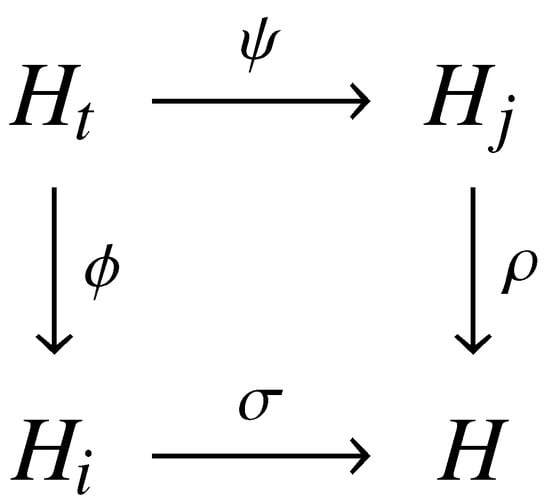
Let H, , and be nilpotent groups. Then with is a nilpotent group and the diagram in Figure 1 is a pullback.

Figure 1.
A commutative diagram of nilpotent groups and morphisms.
Proof.
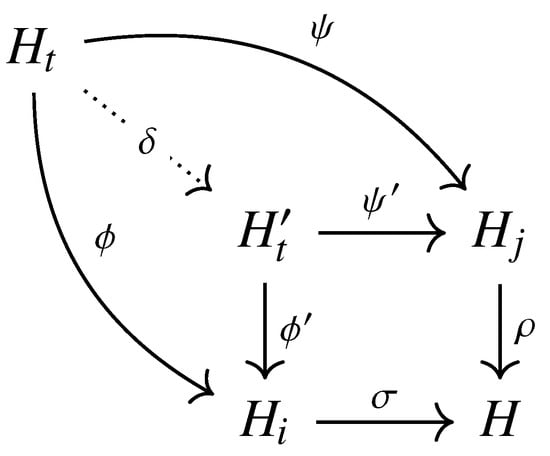
Let . Then is a subgroup of . Figure 2 is a pullback diagram of the diagram in Figure 1. We show here that is an isomorphism. [12]. The two morphisms and define a unique homomorphism such that and . We must prove that is an isomorphism. Let e, , , and be the identity elements of , , , and , respectively. Let . Then, we have that

Figure 2.
Pullback diagram of nilpotent groups.
Suppose that is injective. Then, since the diagram in Figure 1 is commutative, we have that . Thus, by Lemma 1.4 (iii) of [13] we have that and are injective. Therefore, and so . Hence, , and is injective.
Now let . Since , we have that . By assumption, we can write for some a in . Now, suppose that for some . Then . Thus, is surjective and is consequently an isomorphism. □
Theorem 1.
Let and let . Then is an isomorphism.
Proof.
We have that . This implies that the order of is s. Recall that the genus group of H is a cyclic group of finite order s. Thus, is a bijection since . Now, we have that and are cyclic groups; hence, we may find generators and X, respectively. Define the bijection by , for some . Let . Since generates , there exist such that . Thus,
Thus, is a bijective homomorphism and is therefore an isomorphism. □
3. Group Structure on the Genus of A Group
Let act on , that is, we have a nontrivial group homomorphism . Suppose that L is given by , where the action is given by . Then the group L is expressible as a short exact sequence where is the torsion subgroup of L and is the torsion-free quotient. Since is finite and is free abelian of finite rank, we have that . We want to interpret the structure of the group . We will begin by proving some results on the group L.
Proposition 3.
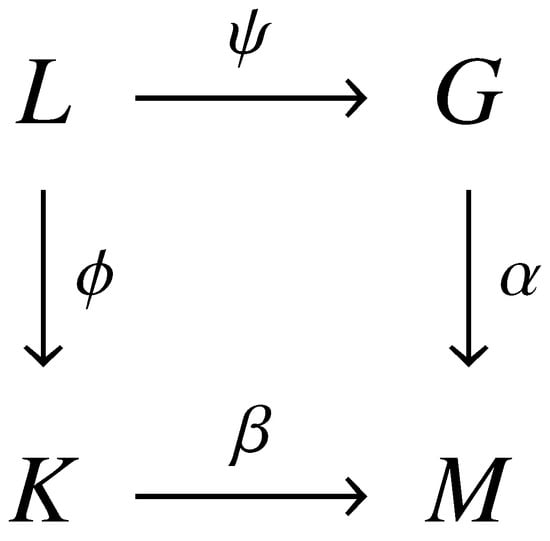
Let be a nontrivial group homomorphism given by , . Let K, G, and M be groups such that and . Let Figure 3 be a commutative diagram of group homomorphisms.

Figure 3.
A commutative diagram of group homomorphisms.
Define a subset L of by
Then L is a subgroup of .
Proof.
Let be a nontrivial group homomorphism given by , . Let . Then, by definition, .
The multiplication on the set L is given by . Then we have
Thus, . Therefore,
- .
Now consider
Therefore, . Note that L is closed under the operation of . Thus, the result follows. □
Proposition 4.
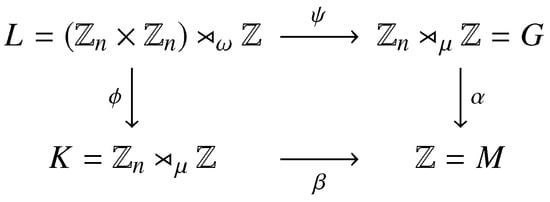
Let be a relatively prime pair of integers. Let be a group action given by , . Let , and . Suppose that α is injective. Then, the commutative diagram Figure 4 is a pullback if and only if the following conditions hold:

Figure 4.
A pullback diagram of nilpotent groups.
- (1)
- ;
- (2)
- ;
- (3)
- .
Proof.
The two morphisms ϕ and ψ define a unique homomorphism . If the diagram is a pullback, then γ is an isomorphism and condition (1) and (2) are satisfied. Now we prove condition (3). Let . By assumption, for some . Then . Since α is injective, , and so . Thus .
Conversely, let . Then there is such that . Since α is injective, we have that . Thus, .
If the three conditions hold, then γ is injective by condition (1). Now let us take . Then, since , we have that , so for some by condition (2). Now, suppose that , for some . Then . Thus γ is surjective. Therefore, the diagram is a pullback. □
We fix some notation.
Let be generated by and suppose that . Then L is given by . Note that the subgroup is normal in L, and so , and similarly . It is given that the group L is non-abelian, hence and . We define two groups by
and
where . We also have that The actions of these groups are given by and , where , and u is relatively prime to n of order d, respectively. We note that .
The properties of the group were discussed in the papers [5,14,15,16]. Here, our focus is to study the relationship between the groups and L. The author in [14] proved the following theorems.
Theorem 2.
Let . Then .
Theorem 3.
Let and let be a cyclic group. Then
Let denote the order of . Set , , and let be the order of , where for all i. We prove the following theorem.
Theorem 4.
Let and be abelian groups. The group is nilpotent.
Proof.
Let , with and be the order of where for all i. Let us write and . Let , be the terms of the lower central series of the group L, where . Then .
Therefore, for sufficiently large r, we have that if and only if for some i. Therefore, the group L is nilpotent. □
Remark 1.
Since , it is clear to see that the commutators are powers of . Thus, , and is obviously finite.
We note that the torsion subgroup of L is noncyclic. Therefore, condition (3) of the definition of is not automatically satisfied. Hence, we prove the following proposition.
Proposition 5.
Let with and commutative. Then L is contained in .
Proof.
We only need to prove condition (3) of the definition of . Let be a group homomorphism given by with , for all and . The image is the inner automorphism group since it is a subgroup of . Since is abelian, then . Therefore, . This implies that . The identity element commutes with every element of a group. Hence, must commute with every element of . Therefore, is contained in the center of . Henceforth, . □
By Proposition 1, we note that the exponent of the group is given by . We now proceed with the analysis of the structure of the genus . Recall the exact sequence (2)
Theorem 5.
Let with a cyclic torsion-free quotient, . Then is a finitely generated cyclic group.
Proof.
Suppose that the sequence (4) is exact, which implies that is a surjective group homomorphism. In addition, we have that . Indeed, since δ is a surjective group homomorphism, we have that is a subgroup of . Further, we have that θ is multiplicative, so that is a subgroup of , consisting of integers m prime to such that for all i, where is the order of . Therefore, , and since we can conclude that , then by the first isomorphism theorem,
□
Since is a cyclic group, we can find a generator . Let c be the least exponent of h such that , where c = pvi−1(p−1)/2.
This gives us the description of the genus group of L,(L). However, we still do not know the exact order of this genus group. In the next section, we compute this order.
In the following theorem we want to prove that for each prime p, the two groups L and Lm such that L ≇ Lm are p−equivalent. We will denote by P′ the set of primes not in P.
Definition 1.
Let L be a nilpotent group. We call the group L P-local if and only if for any , is a bijection for all .
Theorem 6.
Let . Then .
Proof.
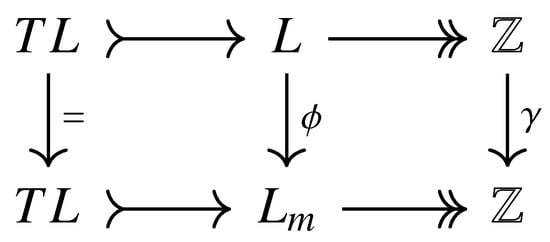
Let . Suppose that there exists a positive integer m such that and . Let and let be defined by , for all . We claim that is a group homomorphism. Indeed, in we have that , so that , but since , then . Thus, ϕ is a group homomorphism and yields a commutative diagram [5] Figure 5.

Figure 5.
A commutative diagram of short exact sequences of groups.
Since , then is P-local, and hence . If we localize at p, then ϕ is a isomorphism. Thus, ϕ is a equivalence, and therefore L is P-equivalent to . □
The authors in [5] used Theorem 6 and Theorem 5 to prove the following corollary.
Corollary 1
(Corollary 2.3 [5]). The group consists of isomorphism classes of groups .
Remark 2.
If L and are nilpotent groups, then they are in the same Mislin genus.
4. A Cyclic Genus of Finite Order
Consider the groups , , and , where is a nontrivial homomorphism given by , and is a nontrivial homomorphism given by , respectively. Consider the pullback diagram of group homomorphisms Figure 6.
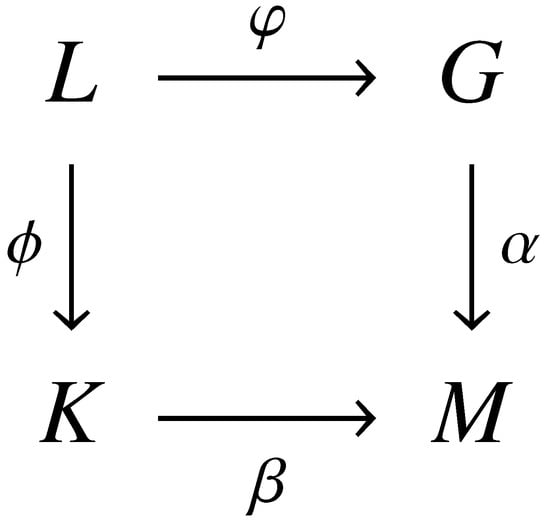
Figure 6.
Pullback diagram of group homomorphisms.
Proposition 6.
Let . Let and be generated by and , respectively. Suppose that . Then the generators of G are subject to the relations and .
Proof.
Let and . Let be a nontrivial group homomorphism. Then G is generated by . We have that the subgroup is normal in G; therefore, . Note that since G is a non-abelian group, we have that . Thus, we have that
where . □
Proposition 7.
Let , for all . Let and suppose that . Then K is generated by the same generators as that of the groups .
Proof.
Let and . Suppose that is a nontrivial group homomorphism. Similarly to proposition 6, the group has generators and relations x and y satisfying and . Furthermore, since K is the direct product of each , for all , we have that K is generated by the same generators. □
The torsion subgroup of K is finite and the torsion-free quotient is free abelian of finite rank, therefore we have that . Let , with acting on by
where u is relatively prime to .
Proposition 8.
Let . Then the genus, , is trivial.
Proof.
Let , where each . Since the direct product of two or more infinite cyclic groups is not cyclic, then the torsion-free quotient is not cyclic. This implies that the genus of K is trivial. Furthermore, the torsion-free quotient of each is cyclic. Therefore, need not be trivial. However, since the torsion subgroup is a cyclic p-group, where p is a prime, and the torsion-free quotient is cyclic, then must be isomorphic to . Thus, is also trivial. □
We observe that if we take the direct product , then . From here, we can discuss the genus of this direct product. In the direct product of K and G, the torsion-free quotient is noncyclic; thus, the genus of this direct product, , is trivial. From this, we can deduce that is an isomorphism. In addition, we have that .
Proposition 9.
Let with a cyclic torsion-free quotient . Then the genus of G is trivial.
Proof.
It is sufficient for us to show that or 2. Let and let , , . We have that if or if . In the second case, since , we have that , and so . Therefore, ; thus, the genus is trivial. □
In the next theorem, we determine the order of the genus of the group L. In particular, we prove that is nontrivial. For the proof of the theorem we need the following proposition, but let us first fix some notation.
Notation. Let a be an integer. We denote by the class which contains all elements a c, where c is the order of the genus group, .
Proposition 10.
Let . Suppose that L is a subgroup of . Then is a surjective group homomorphism.
Proof.
Let and let be defined by , for all , where c is the order of . Let , then
Hence, is a homomorphism and is obviously surjective since every element in is mapped to the identity element. □
Theorem 7.
Let with a cyclic torsion-free quotient group. Then the group is a cyclic group of order 2.
Proof.
Since is mapped to the identity element of , the kernel, must be the group itself. This implies that . In Theorem 5, we showed that is a cyclic group. Therefore, the group can only have one subgroup of order in , which must be the group itself. Then must have only two subgroups: the trivial subgroup and the group itself. Therefore, we can conclude that the genus group of L is cyclic of order 2. □
Example 1.
Let with . Let the action of on be given by and , for all . Thus, and . It is clear that . We claim that is nontrivial. Indeed, . Thus, .
In Proposition 4, we proved that the group is a pullback, where is a nontrivial homomorphism given by . We then proceeded to show that the pullback L is nilpotent with a finite commutator subgroup. In particular, we proved in Proposition 5 that L is contained in the class .
We then considered the groups K and G, where . We proved that is contained in . Since is not abelian, K is not contained in . In this case, the condition that , where is the center of and is the action of on , fails to hold; in general, direct products do not inherit this condition. Therefore, we see the importance of this condition in obtaining the genus of a group in . Propositions 8 and 9 show that the groups and are both trivial, respectively, and therefore are isomorphic to each other.
Finally, in Proposition 10, we showed that there is a surjective homomorphism between the groups and . This surjective homomorphism enabled us to prove that the genus of L, is nontrivial. In particular, we showed in Theorem 7 that is a cyclic group of order 2.
It is clear that the group is an abelian group of finite order. We, therefore, realize an abelian group as a Mislin genus. Now that we have proven that the genus of a pullback L is abelian, we want to further study its subgroups in more detail.
Author Contributions
Conceptualization, T.T., R.K. and J.C.M.; Formal analysis, T.T., R.K. and J.C.M.; Writing—original draft, T.T.; Supervision, R.K. and J.C.M. All authors have read and agreed to the published version of the manuscript.
Funding
This research received no external funding.
Data Availability Statement
No new data were created or analyzed in this study. Data sharing is not applicable to this article.
Acknowledgments
We thank the University of Johannesburg for supporting the APC for the publication of the article.
Conflicts of Interest
The authors declare no conflict of interest.
References
- Mislin, G. Nilpotent groups with finite commutator subgroups. In Localization in Group Theory and Homotopy Theory; Springer: Berlin/Heidelberg, Germany, 1974; Volume 418, pp. 103–120. [Google Scholar]
- Hilton, P.; Mislin, G. On the genus of a nilpotent group with finite commutator subgroup. Math. Z. 1976, 146, 201–211. [Google Scholar] [CrossRef]
- Warfield, R., Jr. Genus and cancellation for groups with finite commutator subgroup. J. Pure Appl. Algebra 1975, 6, 125–132. [Google Scholar] [CrossRef]
- Hilton, P.; Scevenels, D. Calculating the genus of a direct product of certain nilpotent groups. Publ. Mat. 1995, 39, 241–261. [Google Scholar] [CrossRef]
- Casacuberta, C.; Hilton, P. Calculating the Mislin genus for a certain family of nilpotent groups. Comm. Algebra 1991, 19, 2051–2069. [Google Scholar]
- Hilton, P.; Schuck, C. On the structure of nilpotent groups of a certain type. TMNA 1993, 1, 323–327. [Google Scholar] [CrossRef]
- Mba, J.C.; Mai, M.M. On the Genus of A Lattice over an order of a Dedekind Domain. PJM 2020, 9, 142–148. [Google Scholar]
- Hilton, P.; Schuck, C. Calculating the genus of a certain nilpotent groups. Bol. Soc. Mat. Mex. 1992, 37, 263–269. [Google Scholar]
- Casacuberta, C.; Hilton, P. On the extended genus of finitely generated abelian groups. Bull. Soc. Math. Belg. Sér. A 1989, 41, 51–72. [Google Scholar]
- Hilton, P. On the genus of nilpotent groups and spaces. Isr. J. Math. 1986, 54, 1–13. [Google Scholar] [CrossRef]
- Scevenels, D. On the Mislin genus of a certain class of nilpotent groups. Comm. Algebra 1998, 26, 1367–1376. [Google Scholar] [CrossRef]
- Khanehgir, M.; Amyari, M.; KHIBARY, M.M. Pullback diagram of H*-algebras. Turk. J. Math. 2014, 38, 318–324. [Google Scholar] [CrossRef]
- Hilton, P.; Mislin, G.; Roitberg, J. Localization theory for nilpotent groups and spaces. Notas Mat. 1975, 15, 1–34. [Google Scholar]
- Hilton, P. Groups with Operators. In Mathematical Chronicle; Springer: Berlin/Heidelberg, Germany, 1986; pp. 33–44. [Google Scholar]
- Hilton, P. Groups with isomorphic homology groups and non-cancellation in homotopy theory. J. Pure Appl. Algebra 1987, 44, 221–226. [Google Scholar] [CrossRef]
- Hilton, P. Non-cancellation properties for certain finitely presented groups. Quaest. Math. 1986, 9, 281–292. [Google Scholar] [CrossRef]
Disclaimer/Publisher’s Note: The statements, opinions and data contained in all publications are solely those of the individual author(s) and contributor(s) and not of MDPI and/or the editor(s). MDPI and/or the editor(s) disclaim responsibility for any injury to people or property resulting from any ideas, methods, instructions or products referred to in the content. |
© 2023 by the authors. Licensee MDPI, Basel, Switzerland. This article is an open access article distributed under the terms and conditions of the Creative Commons Attribution (CC BY) license (https://creativecommons.org/licenses/by/4.0/).